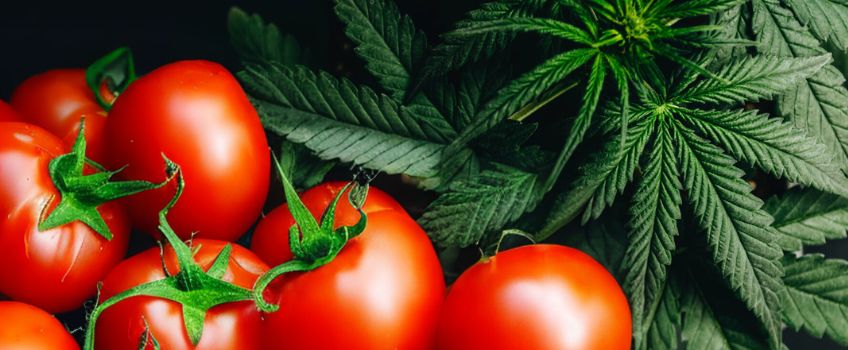Tomatoes and Cannabis, What’s the Real Connection?

By: Noel Criscione-Naylor, Associate Professor of Hospitality & Tourism Management Studies, Stockton University
Krystal Ruiz-Mesa and Lance Eckstein are no ordinary Stockton Hospitality, Tourism and Event Management students. In fact, they started their journey at Atlantic Cape Community College’s Culinary program where they both discovered their love for the food and beverage industry and each other! As the couple has nearly reached their finish line as soon to be graduates, earning their BS degrees, they decided to undertake research related to topics that have a significant impact on today’s food and beverage industry: tomatoes and cannabis.
Noel Criscione-Naylor
Associate Professor of Hospitality & Tourism Management Studies,
Stockton University
Tomatoes
It is not uncommon for Krystal to switch between languages in the classroom to demonstrate her vast areas of knowledge and passion, including Italian. This semester, Krystal focused on Protected Designation of Origin (PDO) products and the challenges they face as they become more of a mainstream attraction in food tourism.
Specifically, Krystal focused on Marzano tomatoes, that hold the prestigious status of being the pinnacle in Italian cuisine, notably in pasta sauces and pizzas. Authentic San Marzano tomatoes are protected by the European Union's PDO, ensuring they are cultivated in the designated area using traditional methods. These tomatoes are prized by chefs and home cooks alike for their culinary versatility. Below are highlights from her research.
Food Tourism
Food tourism involves individuals traveling to a destination with the specific intent of exploring and discovering the local culinary offerings and the unique foods produced in that area. In fact, Italy gets 10.8% of its gross domestic product from international tourists visiting for food tourism. This brings in approximately 194 billion euros as of the 2022 tourism data. There are several regions in Italy known for some of the most prominent food items in the world. The region of Campania where the San Marzano’s grow, according to the OECD 2022 database, “generates most of Campania’s production using wind power (55%), for which it ranked third in Italy” (OECD, 2022, p. 6). Accordingly, Campania has been described as the economic engine of southern Italy, accounting for nearly half of southern Italy’s GDP, 274 billion euros. Nearly 110 billion euros are generated in Naples and surrounding areas. Additionally, the region of Campania has five UNESCO World Heritage Sites.
The region of Emilia Romagna is the No. 1 tourist destination in Italy. While visiting Emilia Romagna, tourists have access to a variety of experiences including visiting the UNESCO World Heritage Site, as well as the birthplace of several prominent foods, including Parmigiano Reggiano cheese, Aceto Balsamico Tradizionale di Modena, Parma Ham, Grana Padano cheese, all in one region. Food items from this region are graded Indicazione Geografia Protetta (IGP), translated to "Protected Geographical Indication" (PGI) in English. IGP indicates that a product's quality, reputation, or other characteristics can be attributed to its geographical origin, and at least one of the production stages occurs in the specified geographical area. This designation aims to protect traditional and regional products, ensuring that consumers can trust the origin and quality associated with that specific geographic area.
This designation aims to protect traditional and regional products, ensuring that consumers can trust the origin and quality associated with that specific geographic area."
San Marzano tomatoes are special because they are grown in a specific region of Italy called the Sarno Valley found in the Campania region, where they have a specific ash content from the famous Mount Vesuvius. Mount Vesuvius is an active volcano that is located above the bay of Naples in Campagna. The volcano became famous because on Aug. 24, 79 CE a cataclysmic eruption took place that covered the city of Pompeii, an UNESCO Heritage Site. This ash count enriches nitrogen, calcium, potassium and sodium nutrients in the tomatoes. An article published in the American Society for Microbiology (Mehlferber et al., 2022) suggests the volcanic ash changes the root biome making it impossible to replicate in other tomatoes. Additionally, Mikkelsen (2005) determined the phosphorus in the soil aids in the balance of acid in the tomato.
Accordingly, San Marzano tomatoes are Denominazione d' Origine Protetta (DOP), translated to “Protected Designation of Origin” (PDO) in English, which means the products are cultivated in that area, with traditional methods. A product that has been given the DOP certification verifies to make sure that some agricultural locations are protected, and part of the money is allocated to preserve the farmlands (Favaro, 2022). As such, where DOP states that the item comes from a particular area, the IGP verifies that the product is grown in that region under those circumstances and is minimally processed. In order for a company to get the IGP designation (according to art. 5 of EU Regulation no. 1151/2012) “at least one of the production steps must be carried out in the area in question.” In summary, the economic impact of San Marzano Organic Canned Tomatoes from Italy account for 75% of tomato products sold outside of Italy. This accounts for approximately 9.6% of the total exports of Italy. Maintaining the production standards and authenticity required for products with the "Denominazione di Origine Protetta" (DOP) designation, or "Protected Designation of Origin," can pose several challenges.
DOP Challenges
Ensuring consistent quality according to the specific standards and traditional methods defined by the DOP designation can be challenging, especially when faced with variations in climate, soil, or other environmental factors. Additionally, when products are made in the United States, there are varying restrictions on food standards as compared to Europe. For example, the Pure Food and Drug Act of 1906 gave the Food and Drug Administration the authority to inspect and regulate what chemicals were deemed safe for human consumption. The FDA currently has the following chemicals under consideration which are banned in Europe due to high correlations with cancer. Chemicals include ethylene oxide, sodium nitrite, titanium dioxide, potassium bromate, and propylparaben (Dudkiewicz et al 2022).
Protecting against counterfeit products or unauthorized use of the DOP label is crucial to maintain the authenticity and reputation of the designated product. Preventing fraud can be challenging, especially in a global marketplace. In 2018, there was a lawsuit against Cento Fine Foods claiming that the San Marzano tomatoes that they were advertising were not grown in the San Marzano region of Italy, but they were grown in another region of Italy with similar highly volcanic soil. Plaintiffs in the case were seeking $5 million for “false advertisement” (Steinberg, 2021). In the end, the lawsuit was dropped.
The food tourism sector holds significant value for any nation and the preservation of culture and culinary heritage remains equally crucial."
The food tourism sector holds significant value for any nation and the preservation of culture and culinary heritage remains equally crucial. Italy stands out in this aspect by leveraging certifications like DOP, affirming the adherence to tradition and local production of food. This commitment ensures the safeguarding of cultural authenticity and sustains the ties between food, tradition and regional identity in Italy. Overcoming these challenges requires a concerted effort among producers, regulatory bodies, and consumers to ensure the continued authenticity and sustainability of DOP products while adapting to changing conditions and market demands.
Cannabis
Regarding cannabis in the food and beverage industry, there has been a growing interest. As states continue to legalize cannabis, this contributes to an already dynamic and complex industry environment. Cannabis can pose various concerns for the hospitality industry due to its impact on legal, health and operational aspects. Additionally, cannabis laws vary widely across different regions and countries. This can create complications for hospitality businesses, especially those operating in areas where cannabis is legalized for recreational and medicinal use, impacting policies on consumption, sale and possession. As a a working culinary professional, Lance has experienced first-hand the impact of drugs and alcohol on the industry and its ability to successful recruit and maintain a qualified workforce. He has concerns as to the impact cannabis will have on the future and new challenges that food and beverage operators will encounter surrounding employment methods and the dynamics involved in accommodating the viewpoints of both employees and guests regarding the legalization of cannabis. Below are highlights from his research.
Cannabis Legislation
Currently 38 states, three territories and the District of Columbia allow the medical use of cannabis products (National Conference of State Legislatures, n.d.). However, cannabis remains illegal at the federal level, creating a complex clash of laws. Furthermore, the Cannabis Regulatory Commission of New Jersey allows for the legal sale and use of cannabis and cannabis products for recreational or "adult-use" for residents 21 years and older. When looking at these considerations, businesses walk a tightrope. Businesses must adhere to the law as well as consider their customers' viewpoints on the legalization of cannabis as part of their overall customer-centric approach. Understanding customer perspectives helps businesses adapt their strategies, policies and services to align with evolving societal norms and preferences. While not all businesses may be directly impacted by cannabis legalization, those in industries like hospitality, and specifically food and beverage, may need to take customers' opinions into account.
Research from the National Bureau of Economic Research has investigated hiring and the intersection with Recreational Cannabis Laws (RML). RML has a history dating back to the colonial period and since then has played a key role in the war on drugs from the 1970’s (Dave, Liang, Muratori, Sabi (2023). Currently RML is being challenged by the Biden Administration to remove cannabis from the controlled substance act (Dave, et al.). Rene Piispanen of Aalto University’s School of Business suggests the stigma of cannabis users needs to be repositioned to make it more culturally accepted, like alcohol use (Grucza, Vuolo, Krauss, Plunk, Agrawal, Chaloupka, & Bierut), which the modification of RML will contribute. Accordingly, this will promote greater accessibility of workers and various minority groups to available jobs. For food and beverage operators, this can help to reduce this added challenge to maintain their workforce.
Modification of RML will support decriminalizing the use of cannabis. Decriminalization is the act of forgiving someone of a previously documented criminal act. As society moves forward with the acceptance of medical cannabis and needs to be extended to recreational use. As more states embrace the recreational use of cannabis, it has been noted that this is no easy task and Petti and Chatlos (2018) explain it is easier for governments to criminalize the use of cannabis then set in place the infrastructure and foundation for the sale of cannabis. This presents yet another challenge for food and beverage operations, especially with varieties of edible products and infusions entering the market.
Business Opportunities and Challenges with Cannabis
In any business, the employees are the epicenter and there must be a balance between aspects of business logistics, profitability and employee retention. Cannabis has created opportunities for new revenue streams and taxation but has also complicated workforce management of cannabis utilization. The Department of Recreation, Tourism, and Hospitality recently made the comparison to how cannabis can become big business to the industry. For example, as tourists go to a destination and can enjoy a flight with beer, wine or spirits, soon they might have the ability to do the same with a variety of flavors of cannabis.

Along with focusing on the traveler, the workplace and how it handles cannabis as compared to other substances, needs to be explored. Hospitality industry jobs often involve safety-sensitive roles where impairment due to cannabis consumption can pose risks. Establishing clear guidelines and policies for cannabis usage while maintaining workplace safety is a challenge. Unlike alcohol, there is not a standardized, universally accepted test to accurately measure impairment due to cannabis. This lack of a reliable testing method makes it challenging for employers to assess on-the-job impairment. There is also a need for comprehensive education and training programs for hospitality workers regarding responsible cannabis use, understanding impairment, and adhering to workplace policies to ensure compliance and safety. Furthermore, businesses are challenged with understanding and managing the preferences of guests. As such, the negative stigma associated with cannabis use may impact how the hospitality industry beyond food and beverage integrates cannabis-related services or products.
Conclusion
While DOP tomatoes and the legalization of cannabis may appear unrelated, they pose significant challenges that affect food tourism and the food and beverage industry. Therefore, it is crucial for industry leaders to remain abreast of advancements in these areas and beyond. Additionally, students must cultivate a comprehensive understanding of the myriad of new trends and phenomena shaping the industry and get that as part of Stockton’s Hospitality, Tourism and Event Management Program. Collaboratively, Krystal and Lance have demonstrated the benefits of exploring these issues and uncovering previously obscured connections to help move the industry forward.
References:
OCED (2022). Better Policies for Better Lives. OCED. https://www.oecd.org/economic-outlook/november-2022/
Dave, D. M., Liang, Y., Muratori, C., & Sabia, J. J. (2023). The effects of recreational Cannabis legalization on employment and earnings (No. w30813). National Bureau of Economic Research DOI 10.3386/w30813
Dudkiewicz, A., Dutta, P., & Kołożyn-Krajewska, D. (2022). Ethylene oxide in foods: current approach to the risk assessment and practical considerations based on the European food business operator perspective. European Food Research and Technology, 248(7), 1951-1958.
Mehlferber, E. C., McCue, K. F., Ferrel, J. E., Koskella, B., & Khanna, R. (2022). Temporally selective modification of the tomato rhizosphere and root microbiome by volcanic ash fertilizer containing micronutrients. Applied and Environmental Microbiology, 88(7). https://doi.org/10.1128/aem.00049-22
National Conference of State Legislatures (n.d.). State Medical Cannabis Laws. https://www.ncsl.org/health/state-medical-cannabis-laws.
Steinberg, J. (2021). Cento ‘Certified San Marzano’ Tomato False Ad Lawsuit Dropped. Bloomerg Law News. https://news.bloomberglaw.com/litigation/cento-certified-san-marzano-tomato-false-ad-lawsuit-dropped




